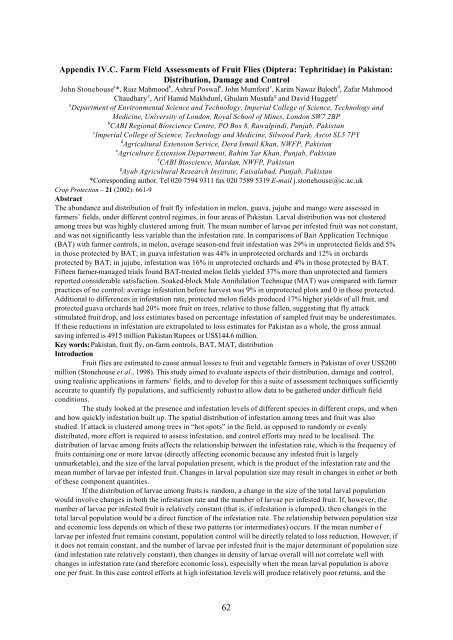“Key Informant Survey” of Production, Value, Losses and ... - DfID
“Key Informant Survey” of Production, Value, Losses and ... - DfID
“Key Informant Survey” of Production, Value, Losses and ... - DfID
Create successful ePaper yourself
Turn your PDF publications into a flip-book with our unique Google optimized e-Paper software.
Appendix IV.C. Farm Field Assessments <strong>of</strong> Fruit Flies (Diptera: Tephritidae) in Pakistan:<br />
Distribution, Damage <strong>and</strong> Control<br />
John Stonehouse a *, Riaz Mahmood b , Ashraf Poswal b , John Mumford c , Karim Nawaz Baloch d , Zafar Mahmood<br />
Chaudhary e , Arif Hamid Makhdum f , Ghulam Mustafa g <strong>and</strong> David Huggett c<br />
a Department <strong>of</strong> Environmental Science <strong>and</strong> Technology, Imperial College <strong>of</strong> Science, Technology <strong>and</strong><br />
Medicine, University <strong>of</strong> London, Royal School <strong>of</strong> Mines, London SW7 2BP<br />
b CABI Regional Bioscience Centre, PO Box 8, Rawalpindi, Punjab, Pakistan<br />
c Imperial College <strong>of</strong> Science, Technology <strong>and</strong> Medicine, Silwood Park, Ascot SL5 7PY<br />
d Agricultural Extension Service, Dera Ismail Khan, NWFP, Pakistan<br />
e Agriculture Extension Department, Rahim Yar Khan, Punjab, Pakistan<br />
f CABI Bioscience, Mardan, NWFP, Pakistan<br />
g Ayub Agricultural Research Institute, Faisalabad, Punjab, Pakistan<br />
*Corresponding author. Tel 020 7594 9311 fax 020 7589 5319 E-mail j.stonehouse@ic.ac.uk<br />
Crop Protection – 21 (2002): 661-9<br />
Abstract<br />
The abundance <strong>and</strong> distribution <strong>of</strong> fruit fly infestation in melon, guava, jujube <strong>and</strong> mango were assessed in<br />
farmers’ fields, under different control regimes, in four areas <strong>of</strong> Pakistan. Larval distribution was not clustered<br />
among trees but was highly clustered among fruit. The mean number <strong>of</strong> larvae per infested fruit was not constant,<br />
<strong>and</strong> was not significantly less variable than the infestation rate. In comparisons <strong>of</strong> Bait Application Technique<br />
(BAT) with farmer controls, in melon, average season-end fruit infestation was 29% in unprotected fields <strong>and</strong> 5%<br />
in those protected by BAT; in guava infestation was 44% in unprotected orchards <strong>and</strong> 12% in orchards<br />
protected by BAT; in jujube, infestation was 16% in unprotected orchards <strong>and</strong> 4% in those protected by BAT.<br />
Fifteen farmer-managed trials found BAT-treated melon fields yielded 37% more than unprotected <strong>and</strong> farmers<br />
reported considerable satisfaction. Soaked-block Male Annihilation Technique (MAT) was compared with farmer<br />
practices <strong>of</strong> no control: average infestation before harvest was 9% in unprotected plots <strong>and</strong> 0 in those protected.<br />
Additional to differences in infestation rate, protected melon fields produced 17% higher yields <strong>of</strong> all fruit, <strong>and</strong><br />
protected guava orchards had 20% more fruit on trees, relative to those fallen, suggesting that fly attack<br />
stimulated fruit drop, <strong>and</strong> loss estimates based on percentage infestation <strong>of</strong> sampled fruit may be underestimates.<br />
If these reductions in infestation are extrapolated to loss estimates for Pakistan as a whole, the gross annual<br />
saving inferred is 4915 million Pakistan Rupees or US$144.6 million.<br />
Key words: Pakistan, fruit fly, on-farm controls, BAT, MAT, distribution<br />
Introduction<br />
Fruit flies are estimated to cause annual losses to fruit <strong>and</strong> vegetable farmers in Pakistan <strong>of</strong> over US$200<br />
million (Stonehouse et al., 1998). This study aimed to evaluate aspects <strong>of</strong> their distribution, damage <strong>and</strong> control,<br />
using realistic applications in farmers’ fields, <strong>and</strong> to develop for this a suite <strong>of</strong> assessment techniques sufficiently<br />
accurate to quantify fly populations, <strong>and</strong> sufficiently robust to allow data to be gathered under difficult field<br />
conditions.<br />
The study looked at the presence <strong>and</strong> infestation levels <strong>of</strong> different species in different crops, <strong>and</strong> when<br />
<strong>and</strong> how quickly infestation built up. The spatial distribution <strong>of</strong> infestation among trees <strong>and</strong> fruit was also<br />
studied. If attack is clustered among trees in “hot spots” in the field, as opposed to r<strong>and</strong>omly or evenly<br />
distributed, more effort is required to assess infestation, <strong>and</strong> control efforts may need to be localised. The<br />
distribution <strong>of</strong> larvae among fruits affects the relationship between the infestation rate, which is the frequency <strong>of</strong><br />
fruits containing one or more larvae (directly affecting economic because any infested fruit is largely<br />
unmarketable), <strong>and</strong> the size <strong>of</strong> the larval population present, which is the product <strong>of</strong> the infestation rate <strong>and</strong> the<br />
mean number <strong>of</strong> larvae per infested fruit. Changes in larval population size may result in changes in either or both<br />
<strong>of</strong> these component quantities.<br />
If the distribution <strong>of</strong> larvae among fruits is r<strong>and</strong>om, a change in the size <strong>of</strong> the total larval population<br />
would involve changes in both the infestation rate <strong>and</strong> the number <strong>of</strong> larvae per infested fruit. If, however, the<br />
number <strong>of</strong> larvae per infested fruit is relatively constant (that is, if infestation is clumped), then changes in the<br />
total larval population would be a direct function <strong>of</strong> the infestation rate. The relationship between population size<br />
<strong>and</strong> economic loss depends on which <strong>of</strong> these two patterns (or intermediates) occurs. If the mean number <strong>of</strong><br />
larvae per infested fruit remains constant, population control will be directly related to loss reduction. However, if<br />
it does not remain constant, <strong>and</strong> the number <strong>of</strong> larvae per infested fruit is the major determinant <strong>of</strong> population size<br />
(<strong>and</strong> infestation rate relatively constant), then changes in density <strong>of</strong> larvae overall will not correlate well with<br />
changes in infestation rate (<strong>and</strong> therefore economic loss), especially when the mean larval population is above<br />
one per fruit. In this case control efforts at high infestation levels will produce relatively poor returns, <strong>and</strong> the<br />
62

















